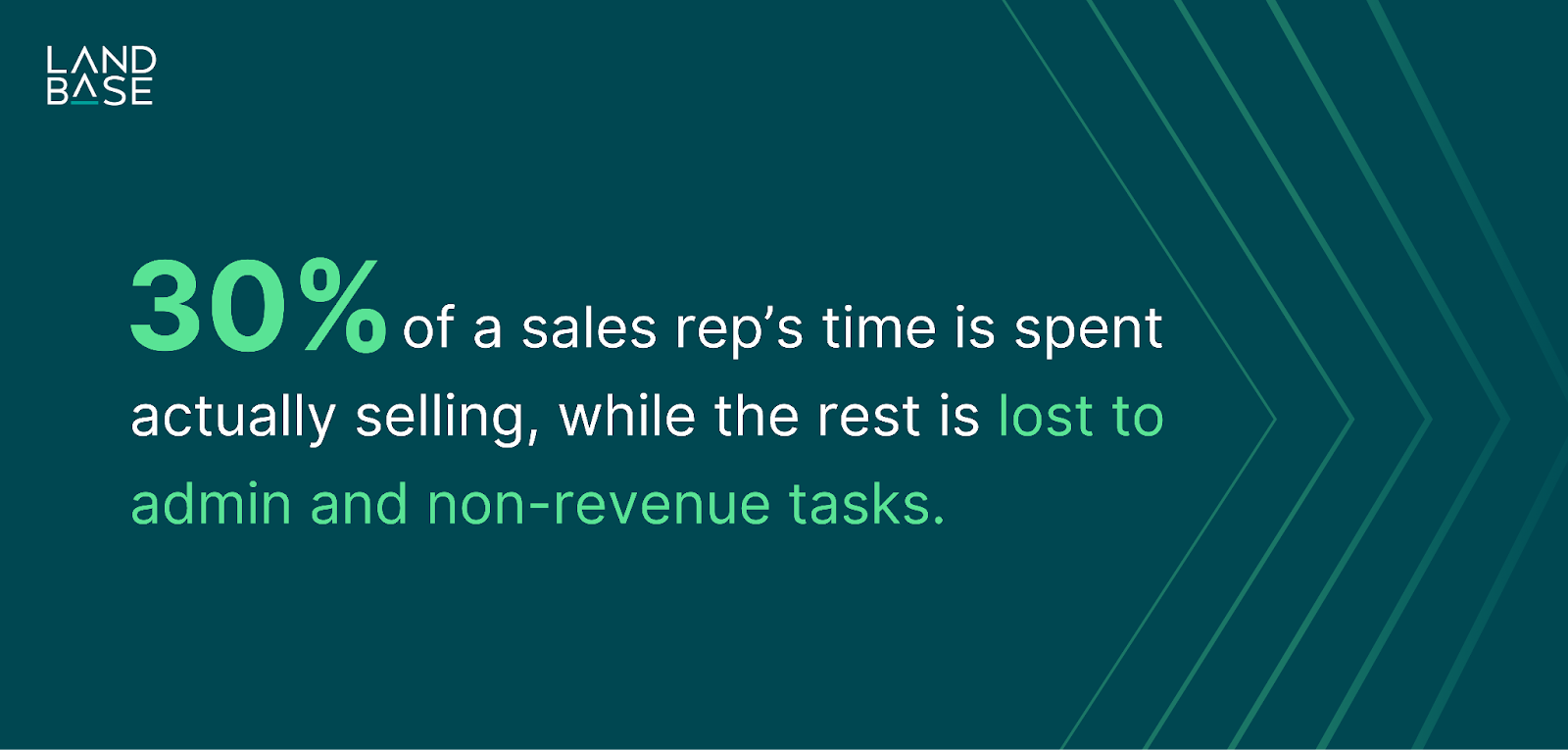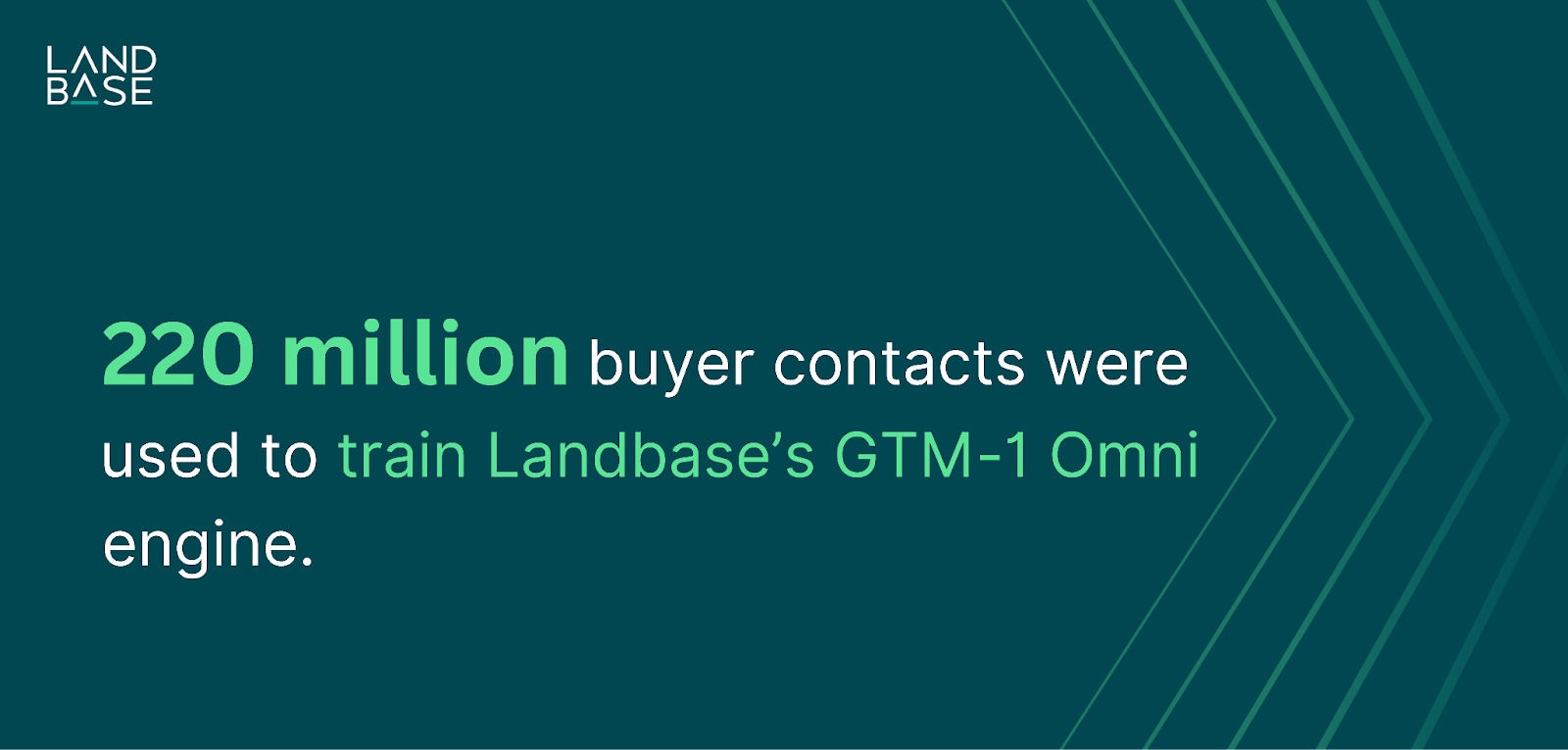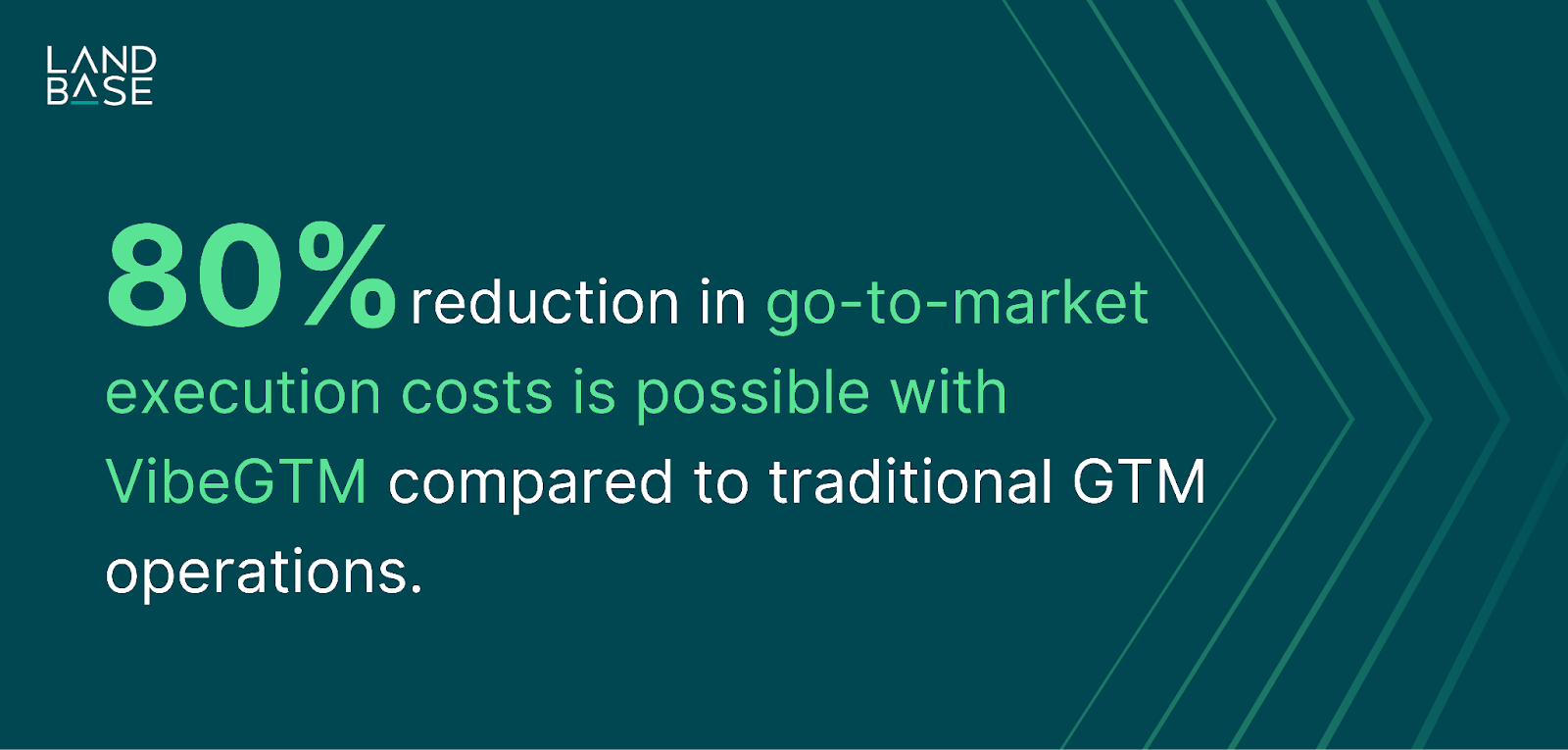
Daniel Saks
Chief Executive Officer

By 2025, an estimated 80% of B2B sales interactions between buyers and suppliers will occur via digital channels(1). This seismic shift toward digital-first selling is reshaping go-to-market strategy and raising the stakes for revenue teams. Enter VibeGTM – Landbase’s autonomous GTM approach powered by agentic AI – designed to meet these modern sales challenges head-on. In this blog, we explore how VibeGTM works, why it’s transformative for sales acceleration in 2025, and how you can leverage this AI-driven model to outpace the competition. By the end, you’ll see why adopting an AI-fueled, autonomous GTM strategy isn’t just a tech upgrade – it’s fast becoming a business imperative.

More than 50% of large B2B deals (over $1 million) will be completed through self-serve digital channels by 2025(2). In an era when 44% of millennial B2B buyers prefer no sales rep interaction at all(1), traditional sales approaches struggle to keep up. Buyers now demand seamless digital experiences and hyper-relevant outreach on their own terms. The result? GTM teams face immense pressure to engage prospects in purely digital, on-demand ways. Static email blasts and quarterly sales calls just don’t cut it when your prospects are researching solutions online and making decisions faster than ever.
Conventional GTM strategies are often too slow and fragmented for this environment. Manual campaign planning, siloed tools, and human bandwidth limitations mean missed opportunities and slow response times to market shifts. If it takes weeks to roll out a campaign or follow up with leads, you risk losing deals to more agile competitors. This is where VibeGTM changes the game. By harnessing agentic AI, VibeGTM enables companies to launch targeted campaigns at machine speed and scale, aligning GTM execution with the digital buyer’s journey. It’s a direct response to the 2025 sales landscape – one where autonomous, always-on engagement is becoming a must-have for growth.

Sales reps spend only ~30% of their time actively selling, with the rest lost to admin tasks and prospecting(3). It’s a startling statistic that underscores the inefficiency of legacy GTM operations. In a traditional model, your team might be bogged down updating CRM records, piecing together lead lists from various databases, and juggling outreach across email, LinkedIn, and phone – all in different tools. Not only does this eat up time, it creates fragmented workflows that stall momentum. One study found that 68% of reps cite note-taking and data entry as their most time-consuming activities, with administrative work eating up nearly half the workweek(3). No wonder pipeline development suffers when humans try to do all these tasks manually.
VibeGTM attacks this productivity bottleneck by introducing autonomy and integration. Instead of salespeople grinding through repetitive chores, intelligent AI agents handle them 24/7. Landbase’s CEO Daniel Saks highlights that many companies use “dozens of tools across their sales and marketing teams,” resulting in siloed decisions and inefficiencies(4). VibeGTM consolidates these disjointed tasks into one cohesive platform. Prospect data gathering, email sequencing, follow-ups, and analytics are all orchestrated under the hood by AI – freeing your human team to focus on high-value activities like closing deals and nurturing relationships. The contrast is stark: a legacy SDR team might spend all week researching and cold-calling with inconsistent results, whereas an AI-driven system can research, personalize, and outreach to hundreds of prospects by the time you’ve had your morning coffee.

Landbase’s VibeGTM can spin up a full multichannel campaign in minutes – not months(5). At the heart of this speed is agentic AI: a network of specialized AI agents that work together like a virtual sales and marketing team. These agents operate 24/7, never taking a break, and can execute GTM tasks at a scale and pace no human team can match. How does it work? At its core is Landbase’s proprietary GTM-1 Omni engine, trained on billions of data points (40M+ sales campaigns and 220M+ contacts) to know what strategies and messaging drive results(5). GTM-1 Omni deploys multiple AI personas – think of them as digital team members with distinct roles:
These agents coordinate through the GTM-1 Omni model to execute campaigns from start to finish with minimal human intervention. It’s essentially like hiring a full “dream team” of SDRs, marketers, and ops specialists, except they work around the clock and only get smarter with time(5). The moment you input a target audience and campaign goal into VibeGTM, the AI strategizes the approach, builds the prospect list, generates tailored outreach content, and starts contacting leads across channels. All of this can happen in under 20 minutes(5) – a process that used to take human teams weeks of prep and coordination. The always-on agents ensure no lead falls through the cracks: every prospect gets timely follow-ups, inquiries from any time zone get immediate engagement, and the outreach doesn’t grind to a halt at 5 PM on Friday. In short, VibeGTM gives you a tireless virtual sales team that never sleeps.

Early adopters of VibeGTM have seen up to 7x higher conversion rates versus traditional outbound campaigns(4). When AI agents handle the top-of-funnel workload, they simply reach more prospects with greater consistency and personalization than a human team could. By automating prospect research and outreach, VibeGTM massively expands the volume and velocity of your pipeline generation. An AI “SDR” doesn’t get tired or capped at 50 calls a day – it can engage hundreds or thousands of leads in parallel, ensuring your funnel stays full. And because the AI is constantly learning which approaches yield responses, it optimizes on the fly to improve conversion metrics continuously.
Real-world results back this up. For example, P2 Telecom, a mid-sized telecom provider, added $400,000 in new MRR during a traditionally slow season by using Landbase’s AI outreach to turbocharge their pipeline(5). “With Landbase, we added $400k MRR in a slow period,” noted the CEO of P2 Telecom, who actually had to pause campaigns because their account executives couldn’t keep up with the influx of opportunities!(5). This kind of growth spurt in pipeline would be virtually impossible with the company’s previous manual efforts. It illustrates how an autonomous GTM engine can unlock revenue that a constrained human team would have left on the table.
The key is that VibeGTM’s agentic AI isn’t just sending more messages – it’s sending smarter messages at scale. It prioritizes the most promising prospects, reaches out on multiple channels, and persistently follows up with each lead until they engage. One global enterprise saw AI-driven prospecting boost conversion rates by 40% and cut lead response time by 30% in mere months(5). By having an always-on “virtual SDR team” relentlessly working your target list, you ensure no pipeline opportunities are missed due to human bandwidth limits(5). The result is a consistently higher volume of qualified leads entering your sales funnel, and ultimately, more deals for your closers.

63% of people say they never respond to non-personalized, generic sales emails(6). In today’s market, blasting out cookie-cutter messaging is a recipe for low engagement. Buyers expect outreach that speaks to their specific pain points and context – but personalization at scale is extremely hard for human teams. Crafting a tailored email for each of hundreds of prospects is beyond the capacity of even the best SDRs. As a result, many organizations resort to one-size-fits-all campaigns that yield meager reply rates.
VibeGTM solves this with AI-driven hyper-personalization. The platform’s AI Marketer agent writes messages as if it had an army of copywriters customizing each one. It draws on troves of data – industry, company size, role, recent news, intent signals – to tweak every subject line and email opening with details relevant to the recipient. The difference in results is night and day: Landbase’s agentic AI was able to send highly tailored communications that felt “very human-like” and had a much higher chance of success in engaging prospects(4). In fact, Landbase reports that early trials of VibeGTM’s personalized outreach drove 7x better response rates than standard, generic outbound methods(5).
Crucially, this level of personalization doesn’t require manual research by your team – the AI automates it. For example, if VibeGTM is targeting a VP of Sales in the software industry, it will automatically incorporate context such as “noticed your company just opened a new office in Europe” or “saw your CEO mention revenue growth goals on LinkedIn” into the messaging, when such data is available. It feels bespoke to the recipient, cutting through the noise in a way template emails cannot. And because the AI learns from each interaction, it continuously refines its personalization approach: if certain pain points or value props get better click-through, it will emphasize those in future messages. This dynamic tuning is how VibeGTM achieves personalization at a scale that would be impossible manually. The outcome for your business is higher email open rates, more replies, and ultimately more conversations with interested buyers – all generated autonomously.

VibeGTM can reduce go-to-market execution costs by up to 80% compared to the legacy approach of hiring staff and buying a stack of point tools(5). The economics of an autonomous GTM engine are compelling. Traditionally, scaling your sales outreach meant scaling headcount – more SDRs, more managers, more training, and more software licenses. Not only is that expensive (an average SDR’s salary plus benefits can run well into six figures, not to mention overhead), it’s also slow. Recruiting, onboarding, and ramping reps takes time, during which market opportunities may pass you by.
By contrast, VibeGTM lets you scale outreach at a fraction of the cost and time by offloading work to AI. Instead of five new SDRs, you might use VibeGTM’s agents to handle the workload of those reps, for a cost closer to a single entry-level hire. Landbase estimates its platform is about 60–70% cheaper than the traditional mix of human labor and a patchwork of sales tools. That’s because you’re consolidating capabilities (data sourcing, email automation, CRM, analytics, etc.) into one AI-driven system and eliminating a lot of manual labor costs. Moreover, the AI doesn’t take vacations, demand commissions, or become less efficient at the end of a long day – it performs consistently around the clock.
The agility gains are just as important. VibeGTM collapses the typical campaign launch cycle from months to minutes(5). Need to pivot your message or target a new market segment on short notice? In a traditional setup, you’d have to reassemble the team, gather new data, create content, and coordinate a rollout – which could take weeks. With an autonomous platform, you simply feed the new parameters to the AI and let it rip. As Landbase’s team puts it, you could decide on Tuesday to test a campaign for a new vertical, and have it live by Wednesday(5). This kind of responsiveness is invaluable in fast-changing markets. Companies can react to competitor moves, inbound inquiries, or emerging trends immediately, without being hamstrung by resource constraints. In practice, that means capturing revenue opportunities that would have been missed in a slower GTM model.
Equally important, an AI-driven system optimizes your spend by automatically reallocating effort to what works. It cuts out wasted marketing dollars by dialing down low-yield activities and doubling down on high-yield ones, all based on real-time data. For example, if the AI sees that calls convert better than emails for a certain segment, it will shift more outreach to phone calls – ensuring your budget (and the AI’s “effort”) is used where it drives the most ROI. This continuous optimization means every dollar and hour invested in GTM goes further than it would in a static, manual approach. In summary, VibeGTM not only lets you do more with less, but also achieve more faster – a critical advantage for any organization looking to accelerate sales efficiently.

84% of salespeople who use AI say it has helped them be more effective by improving and speeding up customer interactions(3). Embracing a platform like VibeGTM doesn’t mean replacing your team – it means augmenting them with AI co-workers to drastically amplify output. The most successful companies treat agentic AI as a force multiplier for their human talent. Your sales reps and marketers still set the strategy and interpret the results, but the AI agents execute the tedious and time-intensive tasks at machine speed. This dynamic allows your human team to focus on what they do best (building relationships, solving complex customer problems, closing deals) while trusting the AI to handle the heavy lifting of prospecting and outreach.
Integrating VibeGTM into your existing operations is designed to be seamless. In fact, the platform was built to plug into common CRM and marketing systems, not to rip-and-replace them(5). That means you don’t have to overhaul your tech stack to get started – the AI can pull data from your CRM, use your current email domains, and work alongside your existing workflows. Many organizations begin with a pilot program: for example, automating outreach for one segment of prospects to compare results against the status quo. Because VibeGTM can be deployed in days, with campaigns launching in minutes, the barrier to trial is low(5). Early adopters often see quick wins (e.g. a surge in meetings booked or a revival of stale leads) that build confidence in the system.
Crucially, you remain in control. VibeGTM’s agents act based on the goals and parameters you set. Think of the AI as a highly skilled assistant: you define the target customer profile, approve the messaging frameworks, and set boundaries (like compliance rules or brand guidelines). The AI then takes initiative within those guardrails. You can monitor campaigns in real-time, and VibeGTM provides performance insights and learnings back to your team. This keeps the human-AI feedback loop tight. As one sales leader put it, adopting AI in GTM is about “trusting your team to oversee AI rather than do everything manually”(5). When done right, your human sellers and marketers partner with the AI – intervening when a personal touch is needed, and letting the agents handle the rest. The result is a harmonious collaboration where the AI accelerates execution and humans ensure strategic guidance and relationship-building never fall by the wayside.
The evidence is mounting that autonomous, AI-driven GTM isn’t just a futuristic idea – it’s happening now, and it’s delivering results. McKinsey research finds that companies investing in AI for sales and marketing are already seeing 3–15% revenue uplifts (and 10–20% higher sales ROI) as a result(7). As they bluntly put it, players that embrace AI are surging ahead, while those that do not risk being left behind(5). VibeGTM represents an opportunity to be one of those forward-looking players. It’s a chance to transform your go-to-market approach from a labor-intensive grind into an intelligent, self-optimizing engine for growth.
By leveraging agentic AI, you equip your organization with a GTM “dream team” that works tirelessly in the background. Campaigns get smarter and more effective every day, your human reps devote their energy to high-value interactions, and your pipeline scales without a commensurate rise in costs. In a business landscape where digital engagement is surging and buyers expect personalization at scale, these capabilities are quickly moving from nice-to-have to must-have. The beauty of VibeGTM is that it doesn’t require a dramatic overhaul to start seeing benefits – it’s an augmentation to your existing strategy. You can begin by having the AI agents tackle one piece of the process (say, lead qualification or initial outreach) and expand from there. With each win, your team’s confidence in the AI will grow, and you can progressively hand over more of the grunt work while retaining strategic oversight.
At the end of the day, succeeding with an autonomous GTM model is as much about mindset as it is about technology. It requires leaders to embrace data-driven decision making and to empower their teams to work with AI in pursuit of common goals. Those companies that foster a culture of innovation and agility will find VibeGTM a natural extension of their toolkit – one that can deliver outsized results with less effort. As you consider the next steps for your own organization, ask yourself: Are we doing everything we can to accelerate growth, or are our traditional processes holding us back? If it’s the latter, it may be time to explore how agentic AI can propel your sales and marketing into the future.
Ready to see autonomous GTM in action? It’s time to stop managing tools and start driving results. Consider scheduling a personalized demo of Landbase’s VibeGTM platform to experience how an AI-driven GTM engine can transform your pipeline. Let the agents do the heavy lifting – and watch your sales team achieve more than ever before.
Tool and strategies modern teams need to help their companies grow.